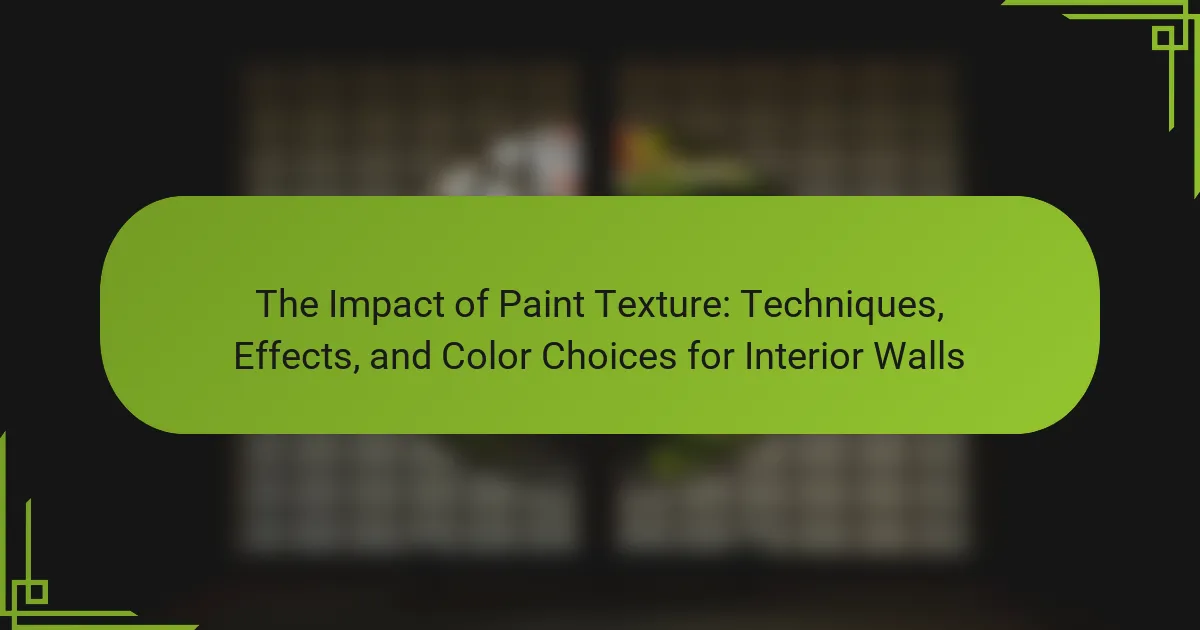
What is the impact of paint texture on interior walls?
Paint texture significantly influences the aesthetic and functional aspects of interior walls. Different textures can create varying visual effects, from smooth finishes that enhance light reflection to rough textures that add depth and interest. Textured walls can also mask imperfections, reducing the need for extensive wall preparation. Additionally, the choice of texture can affect the perceived size of a room; for instance, smooth textures often make spaces appear larger. Textured paint may require more maintenance due to its ability to collect dust and dirt. The choice of texture can also impact the overall ambiance, with softer textures promoting a cozy feel and sharper textures conveying modernity. Ultimately, the right paint texture can enhance the design scheme and functionality of interior spaces.
How does paint texture influence the overall aesthetic of a space?
Paint texture significantly influences the overall aesthetic of a space. Different textures can create varying visual effects and atmospheres. For instance, a smooth finish reflects light and can make a room appear larger. Conversely, a textured finish can add depth and warmth, creating a cozy environment. Textured paint can also hide imperfections on walls, enhancing the overall look. Furthermore, specific techniques like sponging or rag rolling can evoke different styles, from rustic to modern. The choice of texture can complement or contrast with furniture and decor, impacting the harmony of the space. Ultimately, the right paint texture contributes to the intended mood and character of the room.
What are the different types of paint textures available?
There are several types of paint textures available for interior walls. Common textures include flat, eggshell, satin, semi-gloss, and gloss. Flat paint has no sheen and is ideal for hiding imperfections. Eggshell offers a slight sheen, making it easier to clean while still hiding flaws. Satin provides a soft sheen and is durable, suitable for high-traffic areas. Semi-gloss has a noticeable shine and is often used in kitchens and bathrooms for its moisture resistance. Gloss paint has a high sheen and is typically used for trim and moldings, reflecting light and adding depth. Each texture serves a different purpose and can significantly impact the overall aesthetic of a space.
How do various textures affect light and shadow in a room?
Various textures affect light and shadow in a room by altering how light interacts with surfaces. Smooth surfaces reflect light evenly, creating minimal shadows. Textured surfaces, such as stucco or rough paint, diffuse light, resulting in more pronounced shadows. The depth and pattern of the texture influence the intensity and direction of shadows. For example, a heavily textured wall can create dramatic contrasts between light and shadow. Light colors on textured surfaces enhance brightness, while dark colors deepen shadows. The interplay between texture and light can visually enlarge or shrink a space. Overall, textures play a crucial role in shaping the ambiance of a room by manipulating light and shadow.
Why are techniques for applying paint texture important?
Techniques for applying paint texture are important because they significantly influence the aesthetic and functional quality of interior walls. Textured paint can enhance visual interest and depth in a space. It allows for creative expression, enabling homeowners and designers to achieve unique looks. Different techniques, such as sponging or rag rolling, create various effects that can complement a room’s decor. Additionally, texture can help hide imperfections on walls, improving the overall appearance. According to a study by the National Paint and Coatings Association, textured finishes can also affect light reflection and absorption in a room, impacting the ambiance. Thus, mastering these techniques is essential for achieving desired design outcomes.
What are the most common techniques for creating textured walls?
The most common techniques for creating textured walls include sponging, rag rolling, and stucco application. Sponging involves using a damp sponge to apply paint, creating a soft texture. Rag rolling uses a rag to roll paint onto the wall, resulting in a unique pattern. Stucco application provides a three-dimensional texture, often used in outdoor settings. Other techniques include slap brush, which creates a stippled effect, and knockdown, where a textured surface is flattened slightly. Each method offers distinct visual effects and can enhance the overall aesthetic of a room.
How do these techniques vary in difficulty and required tools?
Techniques for applying paint textures vary significantly in difficulty and required tools. Basic techniques like sponging and rag rolling require minimal tools, such as sponges or rags, and are relatively easy for beginners. In contrast, advanced techniques like venetian plaster or stucco application demand specialized tools and skills, including trowels and mixers, making them more challenging. The complexity of the technique often correlates with the level of experience required. For instance, creating a textured finish with a brush may require more practice than simply rolling paint. Each technique’s difficulty also depends on the desired effect and the surface being painted. Therefore, understanding these variations helps in selecting the appropriate method and tools for the project.
What role do color choices play in the impact of paint texture?
Color choices significantly influence the perception of paint texture. Different colors can enhance or diminish the visual effects of texture. For instance, lighter colors often highlight texture more effectively than darker shades. This is due to how light interacts with surfaces. Textured surfaces reflect light differently based on color, creating varying visual effects. Research indicates that the combination of color and texture can alter spatial perception. For example, a textured wall painted in a soft pastel may appear more dynamic than the same texture in a deep hue. Ultimately, the interplay of color and texture can transform the ambiance of a space.
How do different colors interact with various textures?
Different colors interact with various textures by influencing perception and visual appeal. Smooth textures often enhance the vibrancy of bright colors. This effect occurs because light reflects uniformly off smooth surfaces. Conversely, rough textures can mute colors, creating a softer appearance. The irregular surface scatters light, leading to a less intense color experience.
For example, a glossy red on a smooth wall appears bold and striking. In contrast, the same red on a textured surface may look more subdued. Additionally, lighter colors can make textured surfaces appear larger and more dynamic. Dark colors, however, can emphasize texture, creating depth and interest.
Research shows that color and texture combinations affect mood and spatial perception. According to a study by the Journal of Environmental Psychology, texture influences how colors are perceived in a space. This interaction is crucial for interior design choices, affecting ambiance and style.
What are some color combinations that enhance textured walls?
Neutral tones paired with bold colors enhance textured walls effectively. For instance, a soft beige or cream can be complemented by deep navy or rich burgundy. This contrast highlights the texture while maintaining a balanced aesthetic. Additionally, light gray walls can be enhanced with vibrant accents like yellow or teal. These combinations create visual interest without overwhelming the space. Earthy tones, such as terracotta, work well with muted greens for a natural look. The interplay of these colors accentuates the texture, making it a focal point.
How can one effectively combine texture and color for desired effects?
To effectively combine texture and color for desired effects, one should consider the interplay between these elements. Textures can enhance the visual depth of a color, making it appear richer or softer. For instance, a matte finish can absorb light and create a subdued look, while a glossy texture reflects light and adds vibrancy.
Using contrasting textures with similar colors can create interest. For example, pairing a rough textured wall with smooth furniture can highlight both elements. Color theory also plays a crucial role; complementary colors can enhance each other’s vibrancy when used with varied textures.
Additionally, the scale of texture affects perception. Larger textures can make a space feel cozier, while finer textures can create an airy atmosphere. A study by the Color Marketing Group indicates that the right combination of texture and color can significantly influence mood and perception in interior spaces.
Overall, thoughtful combinations of texture and color can transform a room’s aesthetic and emotional impact.
What are the best practices for choosing paint textures and colors?
The best practices for choosing paint textures and colors involve a few key considerations. First, assess the room’s purpose and lighting. Different colors can influence mood and perception of space. For example, lighter colors can make a room feel larger and more open.
Next, consider the existing furnishings and decor. Colors should complement or contrast effectively with these elements. Use color swatches to visualize how different shades look in the actual lighting of the room.
Texture also plays a crucial role. Smooth finishes reflect light and create a modern look. Textured finishes can add depth and interest. Choose a texture that aligns with the desired aesthetic and function of the space.
Finally, test samples on the walls before making a final decision. This allows for an accurate representation of how the color and texture will appear in different lighting conditions throughout the day.
How can homeowners experiment with textures and colors before committing?
Homeowners can experiment with textures and colors before committing by using sample boards. Sample boards allow homeowners to see how different colors and textures look together in their space. They can paint small sections of the wall with various shades. This technique enables homeowners to observe how colors change with lighting throughout the day. Homeowners can also use peel-and-stick wallpaper for temporary texture applications. This method provides a risk-free way to test patterns and materials. Additionally, digital apps can simulate how colors will appear in a room. These tools offer a visual representation without any physical commitment. Homeowners should consider testing combinations in small areas first. This approach helps in making informed decisions that align with their style and preferences.
What are common mistakes to avoid when working with paint texture?
Common mistakes to avoid when working with paint texture include not properly preparing the surface. Surface preparation is crucial for adhesion and durability. Skipping this step can lead to uneven application and peeling. Another mistake is using the wrong tools for texture application. Each texture requires specific tools, such as rollers or brushes, for optimal results. Additionally, applying too much or too little paint can distort the desired effect. This imbalance can create an inconsistent look across the surface. Failing to test the texture on a small area before full application is also a common error. Testing allows for adjustments and ensures satisfaction with the final appearance. Finally, neglecting to account for lighting can affect how textures appear in a space. Different lighting conditions can highlight or diminish texture effects.
How can one maintain textured walls for long-lasting beauty?
To maintain textured walls for long-lasting beauty, regular cleaning is essential. Use a soft brush or vacuum to remove dust and debris. For stains, gently wipe the surface with a damp cloth and mild soap. Avoid harsh chemicals that can damage the texture. Reapply paint every few years to refresh the look. Choose high-quality paint designed for textured surfaces. This helps prevent peeling and fading. Additionally, control humidity levels in the room to avoid moisture damage. Proper ventilation can extend the life of textured walls. Regular maintenance preserves their aesthetic appeal and durability.
The main entity of this article is paint texture, which plays a crucial role in shaping the aesthetic and functional aspects of interior walls. The article explores how different textures influence visual effects, light interaction, and the overall ambiance of a space. It details various types of paint textures, techniques for application, and the importance of color choices in enhancing texture. Additionally, it addresses best practices for selecting and maintaining textured walls, while highlighting common mistakes to avoid during the painting process. Overall, the content provides a comprehensive guide to understanding and utilizing paint texture effectively in interior design.
